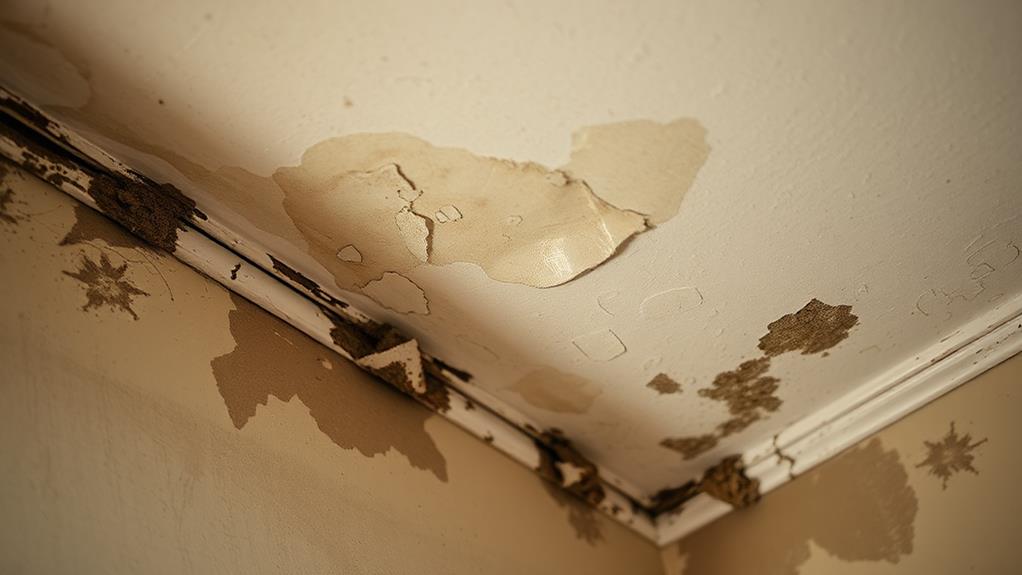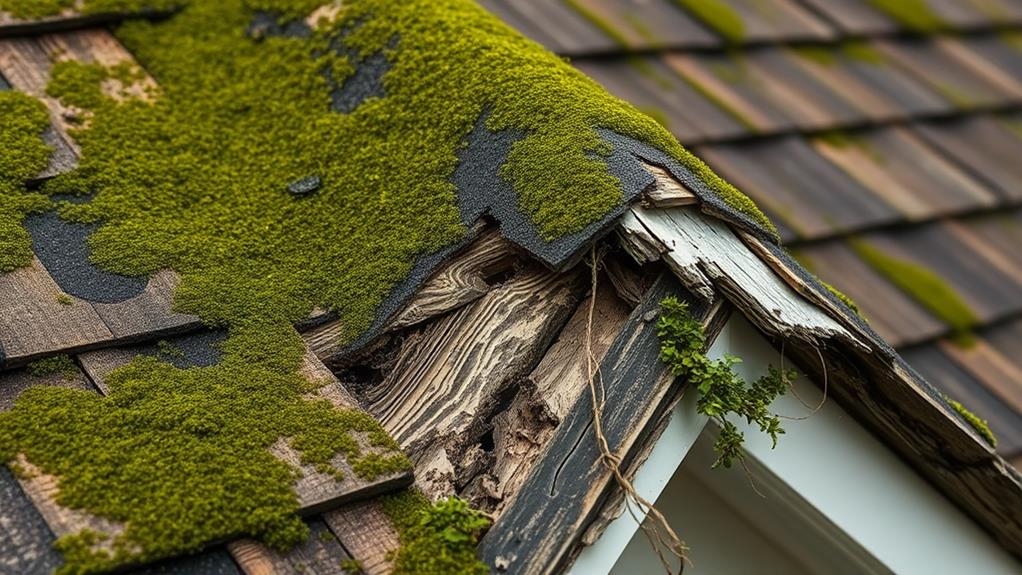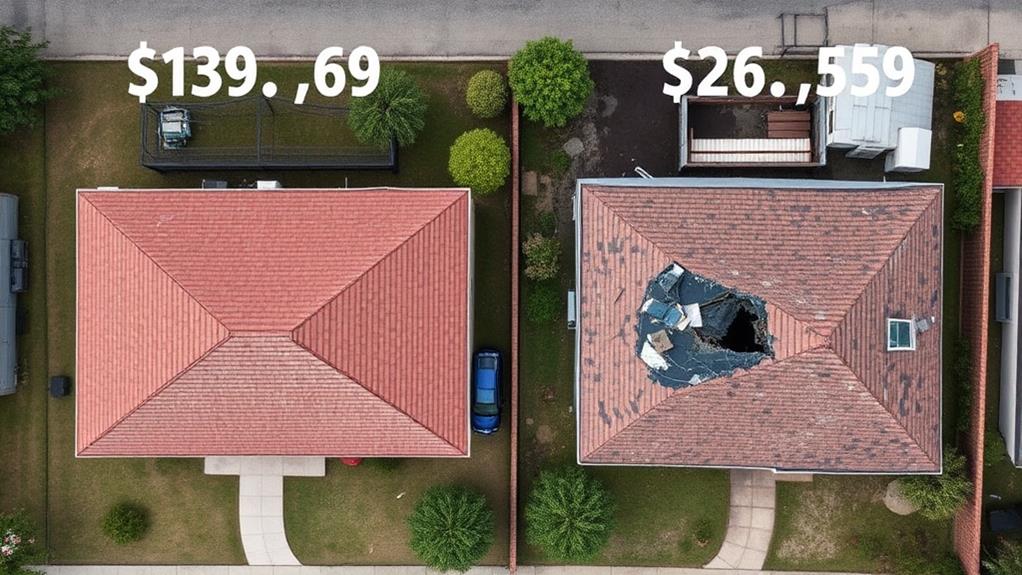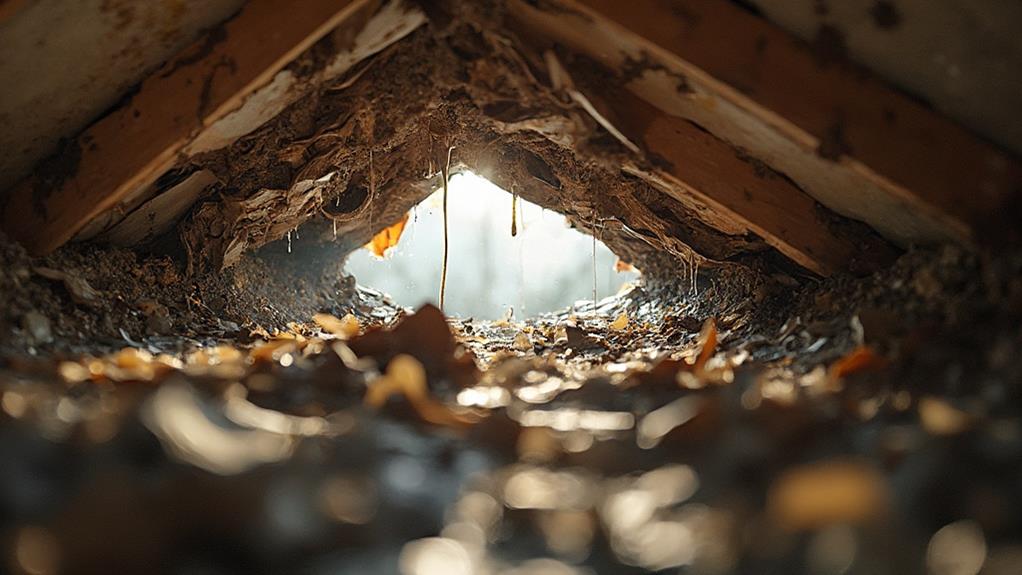Unaddressed storm damage to your roof can have severe long-term consequences. Hidden water intrusion can weaken the underlying structure, leading to wood rot, mold growth, and insulation deterioration. Structural integrity may be compromised, potentially causing sagging and further damage. Mold and mildew proliferation pose health risks and accelerate material breakdown. Energy costs can increase due to compromised insulation and air leaks. Property value may decrease significantly, as damaged roofs are viewed as liabilities by potential buyers and insurance companies. Timely repairs and regular inspections are crucial to prevent these issues from escalating into more extensive and costly problems. Understanding these potential effects is essential for maintaining a safe and valuable property.
Hidden Water Damage

How often do homeowners overlook the insidious threat of hidden water damage after a storm? This silent menace can wreak havoc on a roof's structural integrity long after the storm has passed. Water intrusion, often undetectable from the ground, seeps into tiny cracks and crevices, gradually weakening the roof's underlying structure.
As moisture penetrates the roofing materials, it can lead to wood rot, mold growth, and deterioration of insulation. These issues not only compromise the roof's ability to protect your home but also pose health risks to occupants. The damage may extend to the attic space, affecting electrical wiring, HVAC systems, and even the structural framing of the house.
Left unchecked, hidden water damage can escalate rapidly, leading to more extensive and costly repairs. It's crucial for homeowners to conduct thorough inspections after severe weather events, paying close attention to subtle signs such as water stains on ceilings, peeling paint, or musty odors. Professional roof assessments can detect early signs of water infiltration using advanced techniques like infrared imaging, helping to prevent long-term consequences and ensure the longevity of your roof.
Structural Integrity Compromised
Beyond the visible signs of storm damage, a roof's structural integrity can be severely compromised. High winds, hail, and flying debris can weaken critical components of the roofing system, including trusses, rafters, and sheathing. These structural elements work together to distribute the weight of the roof and maintain its shape, protecting the home from the elements.
When compromised, the roof's ability to withstand future weather events diminishes significantly. Weakened structural components may lead to sagging, which can cause further damage to the roof and the home's interior. Additionally, compromised integrity often results in gaps and openings that allow water infiltration, exacerbating existing issues and potentially leading to mold growth, wood rot, and electrical hazards.
The long-term consequences of unaddressed structural damage can be severe and costly. As the roof continues to deteriorate, it may eventually collapse, posing a significant safety risk to occupants. Furthermore, insurance companies may deny claims for damage that results from neglected maintenance or repairs. To prevent these issues, homeowners should have their roofs professionally inspected after severe storms and address any structural concerns promptly to ensure the longevity and safety of their homes.
Mold and Mildew Growth

Moisture, the silent invader, can wreak havoc on storm-damaged roofs by fostering the growth of mold and mildew. When water penetrates through compromised shingles, flashing, or other roofing materials, it creates an ideal environment for these fungi to thrive. Mold and mildew not only cause unsightly discoloration but also pose serious health risks to occupants and compromise the structural integrity of the building.
The presence of mold and mildew in your home can lead to respiratory issues, allergies, and other health problems, particularly for individuals with weakened immune systems or pre-existing conditions. As these organisms spread, they break down organic materials like wood, drywall, and insulation, further weakening the roof structure and potentially causing extensive damage to the entire building envelope.
Addressing mold and mildew growth promptly is crucial to mitigate both health and structural risks. Regular roof inspections, especially after severe weather events, can help identify potential water entry points and signs of fungal growth. Proper ventilation, timely repairs, and moisture control measures are essential in preventing the proliferation of mold and mildew, ensuring the longevity of your roof and the safety of your home's occupants.
Increased Energy Costs
Storm-damaged roofs can lead to a significant increase in energy costs for homeowners. Damage to shingles, flashing, or underlying structures can create gaps and openings that compromise the roof's insulation properties. These breaches allow conditioned air to escape and outdoor air to infiltrate, forcing heating and cooling systems to work harder to maintain desired indoor temperatures.
Damaged roofs may also lead to water infiltration, which can saturate insulation materials, reducing their effectiveness. As a result, the home's overall thermal efficiency decreases, causing HVAC systems to consume more energy to compensate for heat loss in winter and heat gain in summer.
Additionally, storm damage can affect the roof's reflective properties, particularly if it has a cool roof coating. This can lead to increased heat absorption, further straining cooling systems during hot weather.
The cumulative effect of these issues can result in a substantial increase in monthly energy bills. Homeowners may notice a gradual rise in costs over time as the damage worsens. Prompt repair of storm damage is crucial to prevent these long-term energy efficiency problems and maintain a comfortable, cost-effective living environment.
Decreased Property Value

The impact of storm damage on roofs extends beyond energy costs, significantly affecting a property's overall value. Unaddressed roof damage can lead to a substantial decrease in a home's market value, often outweighing the initial cost of repairs. Potential buyers are likely to view a damaged roof as a major liability, requiring immediate attention and potentially expensive fixes.
Real estate appraisers and inspectors routinely factor roof condition into their property assessments. A roof with visible storm damage or signs of neglect can result in lower appraisal values, making it challenging for homeowners to secure favorable mortgage terms or attract competitive offers. Moreover, insurance companies may increase premiums or even deny coverage for properties with compromised roofs, further diminishing their market appeal.
The compounding effect of unaddressed storm damage can lead to more severe structural issues over time, such as water infiltration, mold growth, and compromised insulation. These problems not only exacerbate the decrease in property value but also make the home less attractive to potential buyers, potentially prolonging time on the market and reducing negotiating power for sellers. Ultimately, investing in timely roof repairs after storm damage is crucial for maintaining and potentially increasing a property's long-term value.
Frequently Asked Questions
How Often Should I Have My Roof Professionally Inspected?
Experts recommend having your roof professionally inspected at least once every 1-2 years. However, this frequency may increase depending on your roof's age, local climate conditions, and any recent severe weather events you've experienced.
Can I Claim Storm Damage on My Home Insurance Policy?
Like Noah preparing for the flood, it's wise to be prepared. Most home insurance policies cover storm damage, but it's essential to review your specific policy. Document the damage thoroughly and contact your insurer promptly to file a claim.
What Are the Signs of Hail Damage on Different Roofing Materials?
Signs of hail damage vary by roofing material:
Asphalt shingles: Circular dents, granule loss
Metal roofs: Dents, dings
Slate tiles: Cracks, chips
Wood shakes: Splits, dents
Clay/concrete tiles: Cracks, chips, or broken pieces
How Long Does a Typical Roof Repair or Replacement Process Take?
Ever wonder how long you'll be without a roof over your head? Typically, roof repairs can take 1-3 days, while a full replacement may require 3-7 days. Factors like weather, materials, and complexity can affect timelines.
Are There Preventative Measures to Protect My Roof From Future Storm Damage?
To protect your roof from future storm damage, consider implementing regular inspections, trimming overhanging branches, installing impact-resistant shingles, reinforcing roof structures, maintaining gutters, and applying weatherproof sealants. These preventative measures can significantly enhance your roof's resilience against severe weather conditions.
Conclusion
As the storm's echoes fade, unseen damage lingers, silently wreaking havoc on neglected roofs. Water seeps through hidden cracks, weakening beams and fostering mold's insidious spread. The once-protective shield now falters, allowing energy to escape and property values to plummet. Like a slowly unraveling tapestry, unaddressed storm damage gradually compromises the entire structure. Swift action and regular maintenance are crucial to preserving the integrity, efficiency, and value of a home's vital crowning feature.

